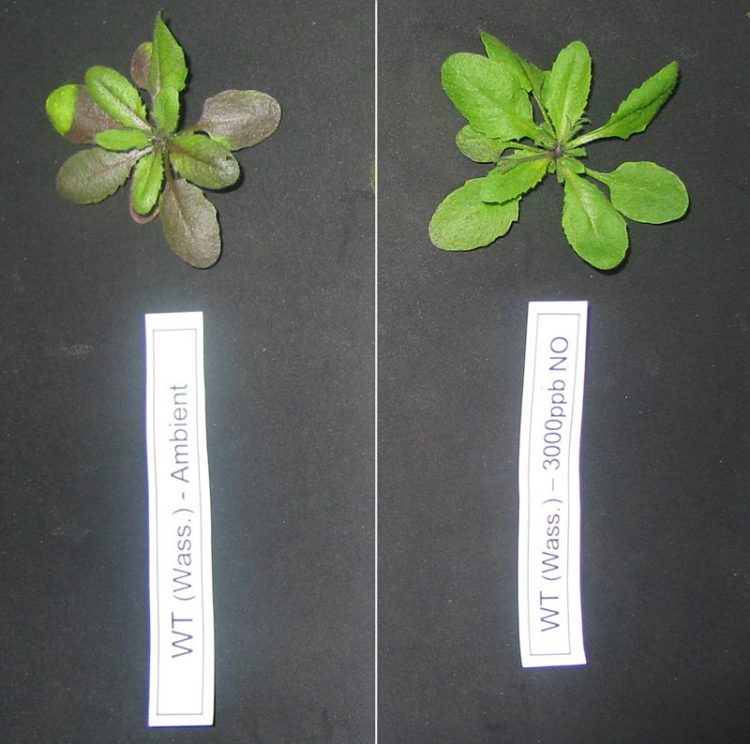Air Purification: Plant Hemoglobin Proteins Help Plants Fix Atmospheric Nitric

Increasing concentrationf of NO leads to a better growth of plants. The plant left was exposed to 0 ppm NO, the plant right to 3.0 ppm NO. Source: HMGU
In Germany, the emission of nitrogen oxides (NOx) amounts to approximately 1.3 million tons per year *. These emissions are mainly caused by combustion processes in industrial facilities and engines.
In humans, the gaseous pollutants particularly irritate the mucous membranes in the respiratory organs and eyes. Until now it was assumed that plants cannot absorb atmospheric NO. Now, researchers of the Institute of Biochemical Plant Pathology (BIOP), in collaboration with staff of the former Institute of Soil Ecology (IBÖ), the Research Unit Experimental Environmental Simulation (EUS) and the Research Unit Analytical BioGeoChemistry (BGC) at Helmholtz Zentrum München have discovered the underlying mechanism that Arabidopsis thaliana plants use to draw NO directly from the air, which they subsequently fix into their nitrogen metabolism.
“We observed that fumigation with high levels of nitric oxide was not toxic, but rather actually improved plant growth,” said Dr. Christian Lindermayr of the Institute of Biochemical Plant Pathology at Helmholtz Zentrum München.
“The mechanism is believed to have originated in order to ensure the survival of plants located at sites with nitrogen deficiency,” said Dr. Gitto Kuruthukulangarakoola, first author of the study who is also a researcher at BIOP.
With regard to the air quality in cities with high concentrations of nitrogen oxides, this property of Arabidopsis thaliana plants could contribute significantly to the reduction of NO and thus improve air quality. This finding may be especially significant for future urban planning in metropolitan areas and may contribute to improved living conditions there.
Further Information
Original Publication:
Kuruthukulangarakoola, G.T. et al. Nitric oxide-fixation by non-symbiotic hemoglobin proteins in Arabidopsis thaliana under N-limited conditions, Plant Cell Environ. 2016 May 31. doi: 10.1111/pce.12773. http://onlinelibrary.wiley.com/doi/10.1111/pce.12773/full
*Source: http://www.umweltbundesamt.de/daten/luftbelastung/luftschadstoff-emissionen-in-d…
The Helmholtz Zentrum München the German Research Center for Environmental Health, pursues the goal of developing personalized medical approaches for the prevention and therapy of major common diseases such as diabetes and lung diseases. To achieve this, it investigates the interaction of genetics, environmental factors and lifestyle. The Helmholtz Zentrum München is headquartered in Neuherberg in the north of Munich and has about 2,300 staff members. It is a member of the Helmholtz Association, a community of 18 scientific-technical and medical-biological research centers with a total of about 37,000 staff members. http://www.helmholtz-muenchen.de/en/index.html
The focal point of the research work carried out by the Institute of Biochemical Plant Pathology (BIOP) is the examination of molecular mechanisms that plants use to adapt to their environment. These include genetic and biochemical processes which control the growth, physiological state and defence mechanisms of the plants. The aim of the research is to better understand the fundamental principles and mechanisms of the interaction between plants and their environment and to develop sustainable strategies for the cultivation and use of plants to protect natural resources. http://www.helmholtz-muenchen.de/en/biop
Scientific Contact
Dr. PD. Christian Lindermayr
Helmholtz Zentrum München –
German Center for Environmental Health
Institute of Biochemical Plant Pathology
Ingolstädter Landstr. 1
85764 Neuherberg
Phone: +49 89 3187 2285
email: lindermayer@helmholtz-muenchen.de
Media Contact
All latest news from the category: Life Sciences and Chemistry
Articles and reports from the Life Sciences and chemistry area deal with applied and basic research into modern biology, chemistry and human medicine.
Valuable information can be found on a range of life sciences fields including bacteriology, biochemistry, bionics, bioinformatics, biophysics, biotechnology, genetics, geobotany, human biology, marine biology, microbiology, molecular biology, cellular biology, zoology, bioinorganic chemistry, microchemistry and environmental chemistry.
Newest articles

Properties of new materials for microchips
… can now be measured well. Reseachers of Delft University of Technology demonstrated measuring performance properties of ultrathin silicon membranes. Making ever smaller and more powerful chips requires new ultrathin…

Floating solar’s potential
… to support sustainable development by addressing climate, water, and energy goals holistically. A new study published this week in Nature Energy raises the potential for floating solar photovoltaics (FPV)…

Skyrmions move at record speeds
… a step towards the computing of the future. An international research team led by scientists from the CNRS1 has discovered that the magnetic nanobubbles2 known as skyrmions can be…





















